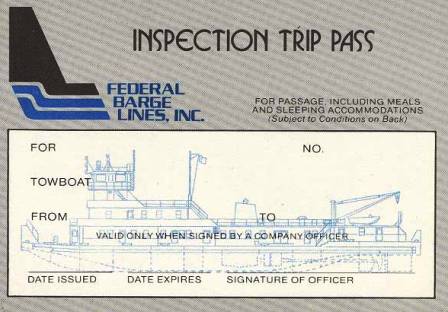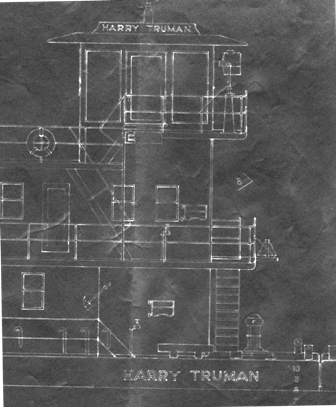P-2: Federal Barge Lines Collection
ABSTRACT: This collection contains significant archival material concerning the history of Federal Barge Lines, a company first ran by the United States government during World War I and eventually sold to Saint Louis Shipbuilding, owned by businesman Herman T. Pott.
SCOPE: The contents of this collection includes primary and secondary materials pertaining to the operation of towboats and barges by Federal Barge Lines, Inc. and built by various shipbuilders from the 1950's through the 1970's. This collection deals with towboats and barges and concerns for their maintenance.
EXTENT: 28 1/2 linear feet of blueprints, papers, and photographs. There are annual reports, advertising, clippings, public relations materials, and history of Federal Barge Lines in The Waterways Journal Collection in the Herman T. Pott National Inland Waterways Library at the St. Louis Mercantile Library.

The Federal Barge Lines materials are arranged into seven series:
Series 1: Finances includes financial statements; barge charter agreements, contracts, and rates; fleeting and towing agreements; maintenance and damage budgets; insurance correspondence; sales information for towboats and barges; and a contract for the salvaging of a sunken barge. The papers are mostly from the 1960's and early 1970's, except for a 1928 consultant's report on the Tri Cities River Terminal at Davenport, Rock Island, and Moline and the Annual Costs and Statistics of the Inland Waterways Corporation for 1938. The papers in this series do not reflect all financial aspects of Federal Barge Lines, but represent the financial considerations of the maintenance and repair of towboats and barges.
Series 2:Traffic includes the costs for specific cargo movements and the notes and considerations used to arrive at those costs, such as: size and type of barge needed; navigational considerations (including weather forecast); repair facilities; cleaning costs; damage costs from loading and unloading; and the towboat requirements including fuel, manpower, and insurance.

Series 3: Operations includes materials about ports visited by Federal Barge Lines; Army Corps of Engineers and Coast Guard information which affected Federal Barge Lines, such as: proposed projects and Lock and Dam 26 information; employee information such as seniority lists, engineer applications, and training programs; safety information; environmental regulations (mostly regarding water pollution) and river stages for the Mississippi River and its major tributaries from 1972 through 1976. This series also contains a list of files relating to Federal Barge Lines' operations which were sent to the National Archives.
Series 4: Engineering and Maintenance contains inventories, descriptions and specifications of barges owned by Federal Barge Lines; financial reports and budgets regarding maintenance of barges and towboats; inspection reports; conversion specifications (for converting steam towboats to diesel and barges for one kind of cargo to barges for another kind of cargo); correspondence regarding maintenance; advertising brochures, catalogs, and operation manuals from companies producing marine equipment, engines, and parts and maintenance products. This series contains rare operation manuals for Busch-Sulzer diesel engines from the 1940's and extensive correspondence with Cooper Bessemer regarding towboat engines and parts. The series contains lubrication and engine performance records for towboats. And Series 4 contains a limited amount of blueprints specific to the maintenance problems being studied. The Engineering and Maintenance Series is divided into two subseries with materials relating to Barges coming first and materials relating to Towboats coming second.
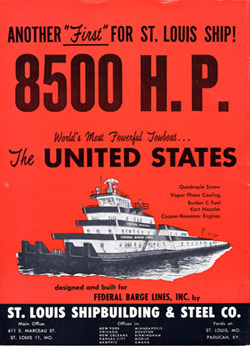
Series 5: Machinery History is a collection of files which were labeled "Machinery History" and deal with the machinery of towboats. They are arranged alphabetically by the motor vessels' names and chronologically for each motor vessel. The materials in the folders describe repairs done to the towboats and include parts requisitions and labor and parts costs. A few machinery blueprints are included when necessary.
The last box of Machinery History files (Box 23) contains files dealing with the re-powering (new engines) of specific towboats, electrical conversion from DC to AC, and renovation specifications.
Series 6: Blueprints consists of 34 boxes of blueprints of towboats and barges which belonged to Federal Barge Lines. The blueprints are divided into two subseries-Towboats coming first and Barges coming second.
The towboat blueprints are arranged by number. Consecutive numbers indicate a single project-one particular towboat. Different builders had different numbering systems and the Inland Waterways Corporation changed numbering systems, so numbers skip around. Therefore, groups of numbers have been given a loosely chronological arrangement. The blueprint plan numbers are found on the right hand side of the folder label and indented under the folder title in this inventory.
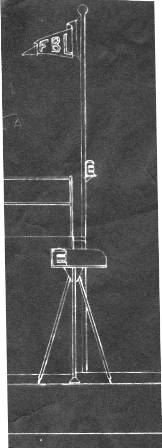
Defense Plant Corporation (D.P.C.) blueprints (mostly for steam powered, twin screw towboats) come first. Blueprints for the Inland Waterways Corporation (I.W.C.) integrated tow (a diesel powered twin screw towboat for a combination of box barges and bow barges) come second. The integrated tow blueprints are for the M/V Harry Truman. Steamer blueprints for steam powered twin screw towboats come third. Twin screw towboat blueprints which were diesel conversions from steamers come fourth. More blueprints for the I.W.C. diesel twin screw integrated towboat, M/V Harry Truman, are separate from the first group because their numbers are different. Plans for quadruple screw towboats with four diesel engines come sixth. And plans for miscellaneous tugboats made by other shipbuilders come seventh. The last blueprint in the towboat subseries is for the reconstruction of the hull of the Santa Maria (which Federal Barge Lines towed up the Mississippi River to St. Louis).
Barge blueprints are arranged by kinds of barges. Covered cargo barges and covered hopper barges come first. Open hopper barges come second. Ocean-going barges come third. Tank barges come fourth. Car floats come fifth. Barge parts and equipment come sixth. And blueprints for the terminal and warehouse at Birmingham, AL come last.
Blueprints within each barge group are arranged chronologically by series or hull number which is given in the folder title. The blueprints are also arranged chronologically by blueprint plan number (listed on the right side of each folder and indented under the folder title in this inventory) which usually turns out to be chronologically by date also. Blueprint numbers beginning with B are for barges, and blueprint numbers beginning with M are for hatch covers. Plans for hatch covers are found right after the plans for the barges for which they are intended.
List of all barges for which there are blueprints, their uses, their builders, and their dates of construction:
COVERED BARGE AND COVERED HOPPER BARGES used for fertilizer, cement, grain, salt, sugar, steel, pipes, tin plate, lumber, paper, and fire brick.
- 200 Series Covered Hopper Barges built by Inland Waterways Corp., 1933
- 250 Series Covered Hopper Barges built by Inland Waterways Corp., 1930-1939
- 280 Series Covered Hopper Barges built by Inland Waterways Corp. and St. Louis Ship, 1938-1956
- Series A Cargo Barges built by Inland Waterways Corp., 1947
- Series B and C Cargo Barges built by Inland Waterways Corp., 1948
- I.W.C. Integrated Cargo Barges built by American Bridge Co., 1947-1948
- Series D Covered Cargo Barges built by St. Louis Ship, 1948-1950
- Bow Barges built by Alabama Dry Dock, 1951
- Semi-Integrated Covered Dry Cargo Barges #613-620 built by Dravo Corp., 1952
- Semi-Integrated Covered Barges #613-620 built by Dravo Corp., 1952
- Semi-Integrated Dry Cargo Barges #621-632 built by St. Louis Ship, 1954
- Miscellaneous Covered Cargo Barges (195' x 35' x 11') built by St. Louis Ship, 1954-1965
- T2000 and other 200 foot Covered Hopper Barges (200' x 35' x 12') built by St. Louis Ship, 1965-1967OPEN HOPPER BARGES used for pulp, coal and ore
- Semi-Integrated Open Hopper Pulp Barges built by St. Louis Ship, 1967OCEAN-GOING BARGES used for coal, raw sugar nuclear reactor parts, and oil well derricks
- Lake and Gulf Cargo Barges built by St. Louis ship, 1957-1973
- Gulf Service Covered Hopper Barges built by Dravo Corp., 1953-1958
- Deck Cargo Barges built by American Bridge Co. and St. Louis Ship, 1958-1970
- Large Ocean-Going Barges built by G.S.I. in 1964 and Zidell Explorations, Inc. in 1965
- Oil Well Derrick Barges built by Inland Waterways Corp., 1942TANK BARGES used for petroleum products, methanol, asphalt, phosphoric acid, soybean oil, molasses, and wine
- Double Skin Oil Barges built by St. Louis Ship, 1968
- Oil Tank Barge #877 converted for molasses by St. Louis Ship, 1955
- Tank Barge #622 converted for sulfuric acid by St. Louis Ship, 1962
- Wine Barges built by St. Louis Ship, 1956
- Oil Refueling Barge built by St. Louis Ship, 1958
- Caustic Soda Barge built by St. Louis Ship, (no date)CAR FLOATS used for transporting railroad cars at Cairo, IL, built by Inland Waterways Corp. in 1931 and revised by St. Louis Ship in 1947.
Series 7: Photos consists of 18 towboat photographs which hung in Robert Labdon's office at Federal Barge Lines; 14 promotional photographs of the M/V Ernest Mack; a promotional photograph of the M/V John Alexa; an aerial photograph of Delta Iron Works, Inc. at Houma, LA; and two photographs of Tank Barge #877 - converted for molasses. All photographs are black and white (Federal Barge Lines Box 57) with other waterways photographs.
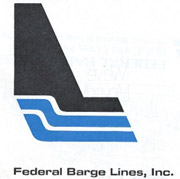
HISTORY: After a congressional committee had surveyed the strain of World War I on the country's transportation facilities, it was suggested that inland waterways and terminals could be utilized to help relieve an acute shortage of railroad cars created by the demands of war. Provisions of the Federal Control Act of 1916 gave control of the railroads to the federal government; and the Director General of the Railroads, Mr. W.G. McAdoo, commandeered all privately owned floating equipment on the Mississippi and Warrior Rivers in 1918. New equipment was purchased and weekly service on the Mississippi River between St. Louis and New Orleans began.
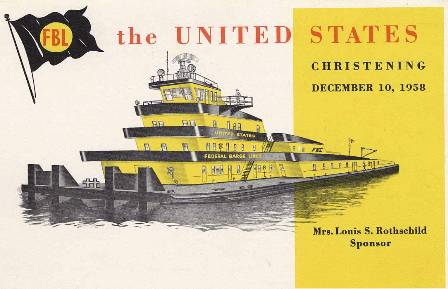
The Inland & Coastwise Waterways Service was established by the 1918 Federal Control Act to serve as a temporary boost to ailing inland waterways companies. All privately-owned equipment on the New York State Barge Canal and the Mississippi and Warrior rivers were commandeered as an emergency measure until new vessels could be built. The Inland Waterways Corporation was created in 1924 "to promote, encourage, and develop water transportation, service, and facilities in connection with the commerce of the United States, and to foster and preserve in full vigor both rail and water transportation." To fulfill the water transportation aspect, the Corporation operated barge lines called the Federal Barge Line on the Mississippi-Missouri and Warrior Rivers. As a result of a successful bid in 1953 a subsidiary of the St. Louis Shipbuilding and Steel Co. took over the Inland Waterways Corporation (Federal Barge Lines).
To read more about the history this corporation, see "The Federal Barge Line," by William J. Petersen, The Palimpsest, vol. 53 (September 1972), pp.390-401. (Copyright 1972. State Historical Society of Iowa. Used with the permission of the publisher.)
Requests for information about Federal Barge Line employees and/or medical records must be in writing with your signature and date to:
National Personnel Records Center: Civilian Personnel Records: 111 Winnebago St.: St. Louis, MO 63118: or Fax: 314-801-9270. If you are writing about someone other than yourself include as much of the following information as possible: name of agency, proof of death, full name used when employed, date of birth, social security number, dates employed, date of separation, what information you are seeking and documents. The National Personnel Records Center is an agency of the National Archives and Records Administration.
Civilian employees of the federal government are listed in the Official Register of the United States, 1816-1959, published every other year. Libraries designated as a federal documents depository library should have this publication.
Information about the content and use of the Official Register
This collection was acquired through donation in 1985 when the Federal Barge Lines equipment was sold to the Ohio River Company, by a gift of John F. Lynch, former president of the Federal Barge Lines. Simultaneously Robert A. Labdon, former marine superintendent - vice president in charge of maintenance and repairs of Federal Barge Lines made a gift of his manuals and photographs.
ACCESS: This is collection P-002. This collection is available for on-site use only in the Rare Book and Manuscripts Reading Room. Some of the collection may be photocopied, digitally scanned or photographed, depending on condition. Researchers are advised to call ahead concerning changes in hours due to University intersessions and holidays. The St. Louis Mercantile Library is located on levels one and two of the Thomas Jefferson Library building. More information about conducting research with the archival collections of the Library, including current building hours and reading room policies, can be found on our Research page.
Preferred Citation note: The preferred citation for this collection is "From the Collections of the St. Louis Mercantile Library at the University of Missouri-St. Louis.”
An Inventory of the Federal Barge Lines Collections
Federal Barge Lines Searchable Database
